
|
Back to |
| The Front Page |
| The Game |
|
Roque: An antique comes alive in Stuart, Florida |
|
by Bob Alman photos by Karen Bullock and Dave Bent Posted May 9, 2011
|
When local croquet pro David Bent told me about Chris Bullock's new roque court in Stuart, Florida - a 45-minute drive north of West Palm Beach - I was immediately interested in pursuing the story, because I knew that roque was a dying mallet sport. Wikipedia classifies roque as "obsolete." I wanted to find out whether Chris was a croquet player looking for an inexpensive alternative to croquet, or a genuine roque fan. Because he's the latter, he had contacted Bent in a search for authentic roque equipment, now very scarce since the roque national association went out of business in the late 50's. It was in the 50's that Chris learned to play roque with his father and grandfather on Cape Cod and became a lifelong fan. Now retired, Bullock is looking to recapture that atmosphere and those memories in his own back yard in Florida, with totally authentic equipment and accurate court settings. So this would be a picture story about a museum piece brought back to life.
With only four entrants, all American, Roque was an Olympic sport in 1904 in St. Louis, replacing the croquet that bombed in the Paris Olympics in 1900. During the Great Depression, many roque courts had been built by the WPA in public parks across America, on the supposition that a space-efficient wicket game on easy-to-maintain public courts was in the spirit of the times. So far as we know, all those courts have passed out of use.
Nevertheless, everything about the Bullock court is accurate - including the "beveled" corners, the smaller balls, and the tight "arches" which Bullock had to make from steel rods bought at the hardware store. When I asked Bullock about the court in Angelica, New York, he was a little skeptical. "It's not really roque as I knew it. The court shape is very different, arch clearance is quite wide, and I don't know what rules they use. Nonetheless, they have great tournaments and lots of fun." The last "official rules" were published in the 50's by the American Roque and Croquet Association, shortly before the association itself went out of business. National championships were held as late as 2004, with fewer than 10 entrants.
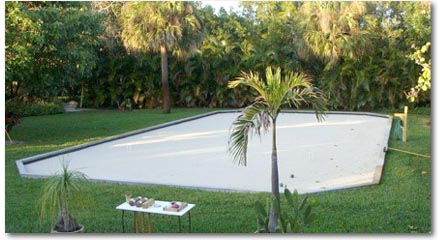
|
| The Bullocks' investment in a 30' by 60' roque court converted their back yard into an activity focus for friends, neighbors, and potential roque players. The court was finished and playable in January, 2011. |
To prepare for my visit to Stuart, on May 3, 2011, I researched the rules and determined that I could "legally" use my croquet mallet, as the only restriction in the roque rules was against changing mallets in the middle of a game. (The best roque mallets have rubber on one end - to facilitate the "roll" shot - and a hard surface on the other.) I also talked with David Bent, who had seen the court and wanted to teach Bullock and his buddies to play "Golf Roque," based on the rules of Golf Croquet. We agreed to visit the Bullock place together on a day of Bullock's choosing.
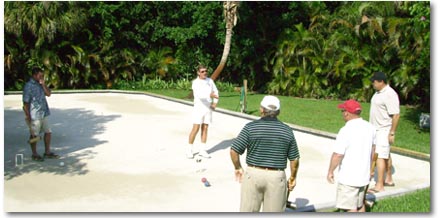
|
| Bent suggested "Golf Roque" to the Bullocks as a good and fast-moving social game for backyard parties. Here, he's instructing a group of four on how to begin the game. |
The early May weather was hot and humid, so we set the time for 4:00 PM. Chris and his wife would prepare some refreshments, and they would invite a few other friends. "Are you planning to start a club?" I asked Chris. "No, he said, I'd just like to find a few people to play the game with on my court, when we come back down south in the fall. We didn't want a pool, the backyard was not being used for anything, and I thought it would be great to bring back the past a bit with memories of great times with my grandfather."
The Bullock court was constructed in the fall of 2010 and was ready to play on by the end of January, 2011. In the course of building it, Chris learned about other roque courts and groups here and there, including a roque court in North Falmouth on Cape Cod recently rebuilt. "My grandfather and I knew nothing of this court when I played with him as teenager," Chris commented. The people in Falmouth provided specs and advice on building the Stuart court. Chris intends to give them some competition when he goes north in mid-May.
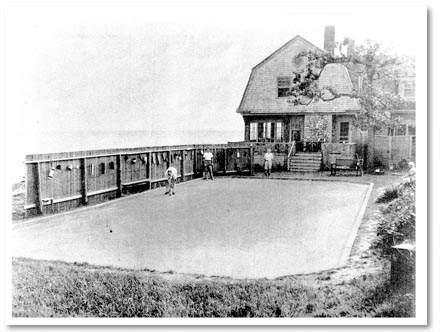
|
| This photo was taken in the '50's in Wild Harbor, North Falmouth, Cape Cod, Massachusetts. Bullock's grandfather Frank W. Kimball (standing rear) and his wife Edith (seated right) are watching two friends play. The fence is a windbreak against Buzzard's Bay. The court is still there. |
"Have you ever heard of C.B. Smith?" I asked Bullock. No, he hadn't. Years after C.B. was a national roque champion - in 1974, 75, and 79 - he became a highly ranked croquet player, using many of the techniques he had mastered for roque - including holding the mallet very low for hoop shots. I played croquet doubles with him once, in the Arizona Open, and disappointed him terribly. He very much wanted to win, and that made me more nervous than I would have been in a low-pressure situation. We did not do well, and we never played doubles together again.
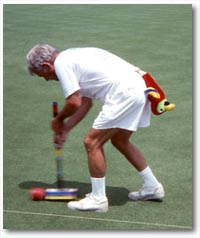
|
| C.B Smith is a cross-over champion from roque to croquet. He was national roque champion three times in the 70's, and when the roque action died away, he successfully converted to croquet, winning a number of major events, including the USCA National Seniors National Championship. He lives in Santa Monica, California. |
Roque can be played one-on-one or as doubles, with strict rotation of the balls, as in Golf Croquet, American Rules, or most varieties of Garden Croquet.
The "Golf Roque" worked just fine on the Stuart court. That game is ideal for a one-court "roque party" because it's interactive and relatively brief, with only one shot allowed per turn. But everybody agreed that for future games, the difficult center "cage" of two closely spaced arches should be eliminated for Golf Croquet, because it tended to bog down the action.
"The demise of the sport was meteoric"
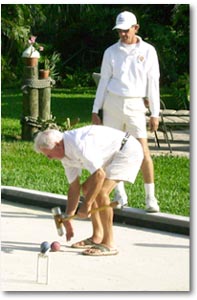
|
| Croquet pro David Bent is Chris Bullock's only close competitor in roque, so far. He watches Chris tamp down the striker ball in preparation for a two-ball "croquet" shot, called a "split shot" in roque. |
But that didn't stop Chris Bullock, once he made up his mind to recreate the roque he remembered with great pleasure from the 50's - even though he had to mount a serious search for building specs and equipment. He lucked out by finding a manufacturer with a small existing stock of balls and willing to sell him one set only. (At first, they proposed selling him 30 sets for between $700 and $800.) For mallets, a computer search led him to the Wilhoite Tool Company, who supplies mallets for "Kentucky croquet," also played on a sand-covered clay court with short mallets fitted with rubber on one end of the head.
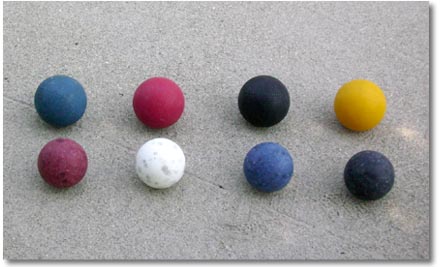
|
| The roque balls in front are smaller than the croquet balls in the second row. The ball colors and sequence are also different, reading left to right. Both are four-ball, two-sided games, with the balls played in sequence in either singles or doubles. |
The hoops, or "arches" were a different matter. Chris had to buy the materials and fashion them himself. On a roque court, the arches do not move around as they do in croquet. They are fixed in concrete, below the surface. There is never a problem of "loose hoops" set in the ground and no issue of "lawn damage" around the arches. All this is handled in standard court maintenance, which is simple once you get the court built. "There's nothing to do, really," Chris told me. "Most of the time you're just removing leaves and other impediments that blow onto the court, and smoothing and sanding isolated spots of damage is easy and fast."
The guys play, the women socialize courtside
Everybody knows that guys are more into competition than women, and that's fine with both sexes, it seems. On this occasion, the result was excellent drinks and munchies courtside under the main shadetree (an avocado) and I was able to enlist Chris' wife Karen to shoot photographs of the action on the court.
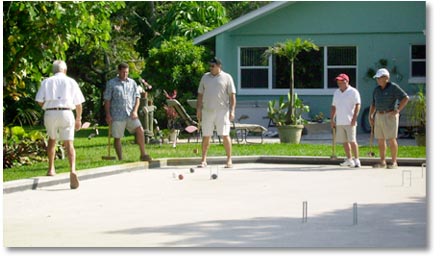
|
| Two different sets of partners confer on the next likely moves in roque doubles. Just as in croquet, the possibilities are many and the consequences of the wrong decision are dire. Just as in croquet, you should confer with your partner on all questionable choices. It's only polite, and it gets you off the hook if your choice doesn't turn out well! |
During the games, Bent advised Bullock to reduce the amount of sand on the court to make it a truer surface. Both of them are excellent shot-makers, while their visiting friends were less expert and seldom hit the ball as hard as Bullock or Bent. Hitting the ball hard tends to give it a truer course. And you need a hard shot to employ the billiards-like tactic of bouncing off the concrete sidewall for a better chance of achieving an advantageous position on the opposite side of the 30' x 60' court.
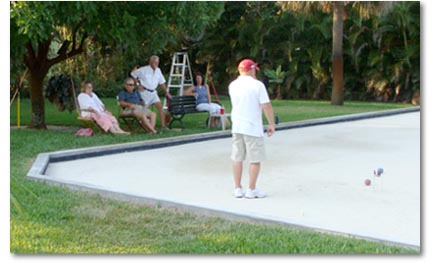
|
| It's polite for the out-player to stand off the court in roque as it is in croquet. Chris stands behind the spectator gallery waiting for his singles opponent to choose his next shot. |
With its modest dimensions and ease of maintenance, roque is a rational alternative to grass-court croquet. I wouldn't be surprised if Golf Roque expands the revival of roque in America, spurred by the new Bullock court in Florida, the restored court on Cape Cod, the action in Angelica, New York, and other as yet unknown roque cells around the country waiting to happen.
ABOUT THE BUILDER: Chris Bullock is a retired Toyota Dealer who summers in Centerville, Cape Cod, Massachusetts and winters in Stuart, Florida with his wife Karen. He is willing to correspond with people who want basic information about building their own roque court and finding equipment, or who would like to play on his court in Florida during the winter season. Email him at karenb071@comcast.net